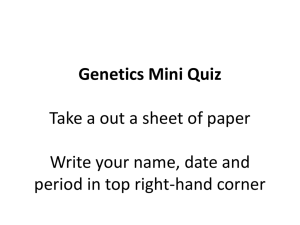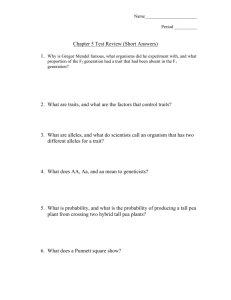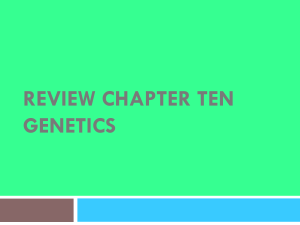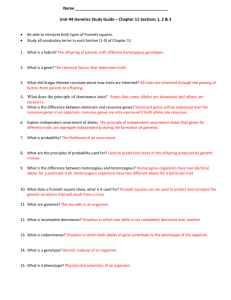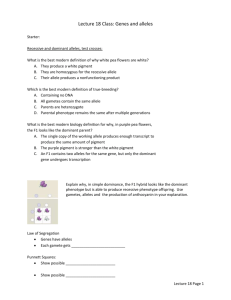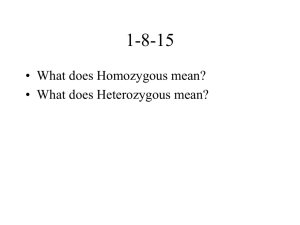Pre-AP Biology - Semester 2 SG Answers
advertisement
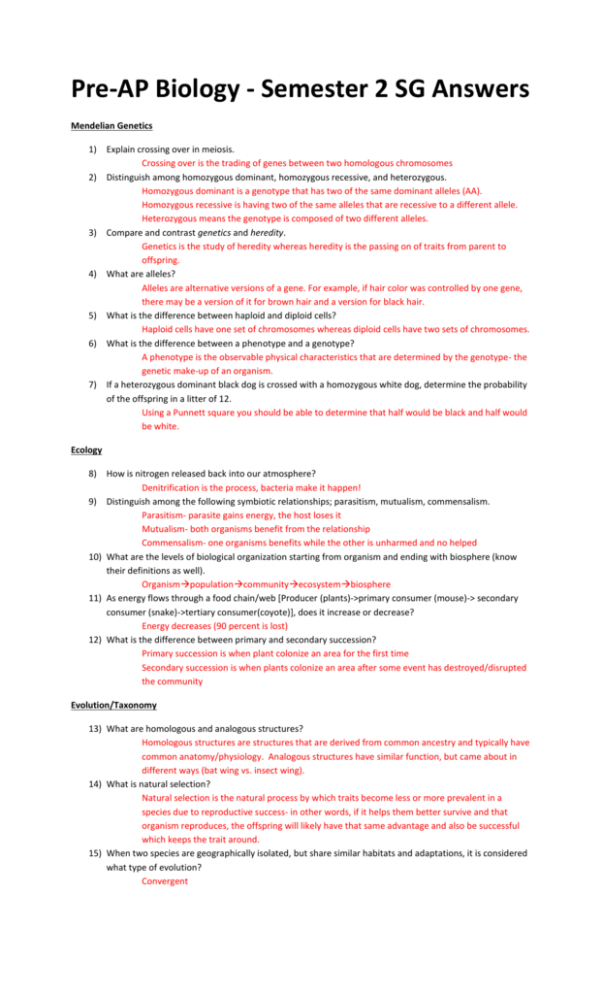
Pre-AP Biology - Semester 2 SG Answers Mendelian Genetics 1) Explain crossing over in meiosis. Crossing over is the trading of genes between two homologous chromosomes 2) Distinguish among homozygous dominant, homozygous recessive, and heterozygous. Homozygous dominant is a genotype that has two of the same dominant alleles (AA). Homozygous recessive is having two of the same alleles that are recessive to a different allele. Heterozygous means the genotype is composed of two different alleles. 3) Compare and contrast genetics and heredity. Genetics is the study of heredity whereas heredity is the passing on of traits from parent to offspring. 4) What are alleles? Alleles are alternative versions of a gene. For example, if hair color was controlled by one gene, there may be a version of it for brown hair and a version for black hair. 5) What is the difference between haploid and diploid cells? Haploid cells have one set of chromosomes whereas diploid cells have two sets of chromosomes. 6) What is the difference between a phenotype and a genotype? A phenotype is the observable physical characteristics that are determined by the genotype- the genetic make-up of an organism. 7) If a heterozygous dominant black dog is crossed with a homozygous white dog, determine the probability of the offspring in a litter of 12. Using a Punnett square you should be able to determine that half would be black and half would be white. Ecology 8) How is nitrogen released back into our atmosphere? Denitrification is the process, bacteria make it happen! 9) Distinguish among the following symbiotic relationships; parasitism, mutualism, commensalism. Parasitism- parasite gains energy, the host loses it Mutualism- both organisms benefit from the relationship Commensalism- one organisms benefits while the other is unharmed and no helped 10) What are the levels of biological organization starting from organism and ending with biosphere (know their definitions as well). Organismpopulationcommunityecosystembiosphere 11) As energy flows through a food chain/web [Producer (plants)->primary consumer (mouse)-> secondary consumer (snake)->tertiary consumer(coyote)], does it increase or decrease? Energy decreases (90 percent is lost) 12) What is the difference between primary and secondary succession? Primary succession is when plant colonize an area for the first time Secondary succession is when plants colonize an area after some event has destroyed/disrupted the community Evolution/Taxonomy 13) What are homologous and analogous structures? Homologous structures are structures that are derived from common ancestry and typically have common anatomy/physiology. Analogous structures have similar function, but came about in different ways (bat wing vs. insect wing). 14) What is natural selection? Natural selection is the natural process by which traits become less or more prevalent in a species due to reproductive success- in other words, if it helps them better survive and that organism reproduces, the offspring will likely have that same advantage and also be successful which keeps the trait around. 15) When two species are geographically isolated, but share similar habitats and adaptations, it is considered what type of evolution? Convergent 16) What are the 5 facets of evolution (your hand is a cheat sheet!)? Equilibrium- no natural selection, no gene flow(migration), no mutations, random mating, large population size Evolution- natural selection, gene flow, mutations, selective mating, small population size 17) What are vestigial structures? Structures that have no apparent use but are indicators of common decent 18) What are the three types of selection models for natural selection? Directional, stabilizing, diversifying 19) Taxonomy, the science of grouping and naming organisms, used what two-part naming system? Binomial nomenclature Kingdoms of Life 20) What is a virus that only infects bacteria called? a. bacteriophage 21) How are bacteria classified? (you also need to know what strepto-, staphlyo-, bacilli, and cocci mean) By their shape and groupingStrepto- chained Staphlyo- clustered Bacilli- rod-like Cocci- spherical 22) How are most protozoans classified? By the way they move—cilliates use… flagelletes use… 23) How are most Fungi classified? By their reproductive structures 24) What are the three types of symmetry (know their definitions)? Asymmetry, bilateral symmetry, radial symmetry 25) What is a nematocyst, what do they respond to, and what phylum has them? It is a stinging cell found in Cnidarians (jellyfish, anemone, hydra, coral) that activate in response to a physical trigger 26) How do adult sponges feed? They are filter feeders 27) What phylum do bivalves (2-shelled), gastropods (stomach-foot), and cephalopods (head-foot) belong to? Mollusca 28) What does arthropod mean, and what are the four sub-phyla of arthropods we covered? Jointed-foot; Hexapoda, chelicerata, myriapoda, crustacea 29) How do fish detect vibrations? Lateral line system 30) What are the characteristics of amphibians, reptiles, birds, and the three types of mammals? Amphibians- smooth, moist skin, no claws Reptiles- dry, scaly skin, claws/plates, amniotic egg Birds – feathers, endothermic, 4 chamber heart Mammals- hair, mammary glands, birth to live young Plants 31) What do roots do for a plant? Absorb water/minerals 32) What is the function of leaves? Capture of sunlight, production of sugars (photosynthesis) 33) What are plant cell walls made of? Cellulose

